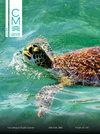热带潮间带岩池鱼类采样的优劣:目测普查与岩池戽斗法的比较
IF 0.7
4区 生物学
Q4 MARINE & FRESHWATER BIOLOGY
引用次数: 0
摘要
潮间带岩池鱼类研究采用了多种取样方法。对这些方法的性能和适用性进行比较的信息很有限,这使得不同研究之间的比较变得复杂。我们在 10 个岩池中比较了戽斗法和目测普查法的性能,以量化岩池潮间带系统中鱼类的丰度、物种丰富度和组合结构,同时考虑到鱼类的栖息地亲缘关系、岩池体积和底质崎岖度。2018 年 6 月至 12 月期间,在全套 10 个岩池中进行了 13 次采样。每个岩池都采用目测普查法进行取样,然后再采用戽斗法取样。一次取样活动的定义是,在一个岩池中同时进行目测和戽斗调查的过程。使用戽斗法共检测到 14 个物种的 1 749 个个体,而通过目测普查则记录到 8 个物种的 438 个个体。与目测普查相比,戽斗法获得了更高的常住鱼类、机会鱼类和暂居鱼类的丰度和物种丰富度。在两种方法中,个体和物种的发现量与岩池体积呈正相关,而与底质崎岖度呈负相关。在 32 个取样事件中,戽斗法检测到的鱼类纠正了目测普查记录的无鱼报告(假阴性)。在戽斗法中,常住鱼类在鱼类群落中占主导地位,而在目测普查法中,常住鱼类和机会鱼类对群落的贡献相似。本文章由计算机程序翻译,如有差异,请以英文原文为准。
The good and the better, sampling tropical intertidal rock pool fishes: a comparison between visual census vs. rock pool bailing method
Numerous sampling methods have been applied to study intertidal rock pool fishes. There is limited information comparing the performance and suitability of such methods, which complicates comparisons between studies. We compared the performance of the bailing and visual census methods in 10 rock pools to quantify abundance, species richness, and structure of fish assemblages in rock pool intertidal systems considering fish residency affinities, rock pool volume, and substratum rugosity. Sampling was conducted 13 times across the complete set of 10 rock pools from June to December, 2018. Each of the pools was sampled with a visual census and then the bailing method. A sampling event was defined as the process of conducting both a visual and a bailing survey in a single rock pool. In total, 1,749 individuals of 14 species were detected using the bailing method, whereas 438 individuals of 8 species were recorded via visual census. The bailing method yielded higher abundance and species richness of resident, opportunist, and transient fish than the visual census. The detection of individuals and species showed a positive association with rock pool volume and negative association with substratum rugosity for both methods. In 32 sampling events, the bailing method detected fish correcting reports of fish absence (false negatives) recorded with the visual census. For the bailing method, resident fishes dominated the fish assemblage, whereas, for the visual census, resident and opportunist fishes contributed similarly to the community.
求助全文
通过发布文献求助,成功后即可免费获取论文全文。
去求助
来源期刊

Ciencias Marinas
生物-海洋与淡水生物学
CiteScore
1.10
自引率
0.00%
发文量
9
审稿时长
>12 weeks
期刊介绍:
A bilingual open-access publication, Ciencias Marinas (CM) is an international peer-reviewed journal that contains original research findings in all areas of marine science. It is published quarterly by the Autonomous University of Baja California, Mexico, and all its contents are publicly available on our journal website. Though a limited number of copies are still printed, the journal is mainly distributed in its electronic format.
CM was conceived in 1973 as part of an academic project aimed to entice local researchers to publicly disclose their findings by adopting the culture of peer-review publishing. This academic project evolved into an international journal after accepting papers from researchers in the United States and, eventually, other parts of the world. Because of the diversity in authorship, CM issues were initially published in either Spanish or English, and occasionally in both languages. It was not until 1984 when CM included both language versions of all its contents, and it then became the fully bilingual journal it still is today. At CM we believe our inclusive format allows us not only to address a wider range of submissions from international authors but also to make published findings available to a wider international audience.
So whether you are looking for information on the redfish in Icelandic waters or the physical and biological properties of the Gulf of California, feel free to peruse CM contents. You may find them to provide source material for your research.
 求助内容:
求助内容: 应助结果提醒方式:
应助结果提醒方式:


